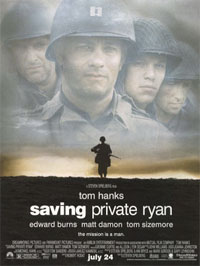Saving Private Ryan

Battle Plans
The re-creation of the massive D-Day landing at Omaha Beach was, perhaps, the most formidable challenge facing Spielberg and company.
The first order of business was to find a suitable location. The beach where the original event took place is not only a protected historical landmark, but had become far too developed over the years. After weeks of research, production designer Tom Sanders accompanied the location scouts to a variety of beaches in France, England and Ireland. It was in Ireland that they found a perfect stretch of coastline that was uncannily similar to Normandy, from the golden color of the sand to the line of windswept cliffs set back from the shore.
Sanders and his team then transformed the Irish coast into the German stronghold at Normandy, complete with the defensive Belgian gates and iron hedgehogs. On the beach, they built a "shingle," a low seawall of rocks and sand topped with barbed wire. They also dotted the cliffs with pillboxes, the mini-forts from which the Germans rained down a relentless barrage of gunfire.
One of producer Ian Bryce's more difficult tasks was tracking down any World War II-era landing craft--called Higgins boats--still in existence. "Tanks and other vehicles are quite plentiful, but we had to look all over the world for the landing craft. Some were discovered in England and a couple in Scotland, but interestingly enough, we found the majority of them in Palm Springs, California," Bryce recalls. The landing craft were then shipped to England and refurbished for the invasion sequence.
An invasion calls for a sizable number of armed forces, and when you need armed forces, the best place to turn is the military. The Irish army provided 750 extras for the D-Day scene, many of whom were movie veterans, having worked on Mel Gibson's "Braveheart."
Feeding and costuming so many extras might have been a logistical nightmare were it not for a system dubbed "the sausage machine," originally perfected by associate producer Kevin De La Noy when he also worked on "Braveheart." The extras were broken down into 15 groups of 50, which were fed, clothed and made up in varying order. At the end of the day, each group went back through the system in reverse. It worked like a proverbial well-oiled machine.
Virtually none of the uniforms from World War II are still in existence today, so costume designer Joanna Johnston had to have more than 3,000 authentic uniforms of the day made from scratch to outfit all the principals, as well as the many extras. Johnston also located the company that made the original American troops? boots and had 2,000 pairs of boots made using the same pattern. Then, all the uniforms and boots had to be put through an aging process to make them appear battle-worn.
Though the military style of the film didn't allow her much creative leeway, Johnston found ways to reflect specific traits of the main characters in their uniforms. Captain Miller's guardedness, for example, is seen in his assault vest and his helmet pulled low, shadowing his eyes. Reiben's uniform is the scruffiest because he likes to break the rules and go against the grain, while Jackson's uniform epitomizes a warrior with his ammunition always at the ready. Having seen no combat, Upham starts out very pristine and slowly takes on a battle-worn appearance.
Donning the uniforms had a profound effect on the main cast, arriving on the set only days out of boot camp. Diesel remembers, "All the research we had done could not have prepared us for the feeling that you got when you had the uniform on. Standing on that expanse of beach with the Higgins boats in the water...it was breathtaking. It was only then that I could start to appreciate what the soldiers in World War II felt like at Omaha Beach."
In any war movie, guns are an integral accoutrement to the soldiers' uniforms. It took armorer Simon Atherton three months to gather or create the 2,000 weapons necessary for the production. Atherton and his team were also responsible for daily inspections of every gun for sand and debris which could create obstructions in the barrels and make them unsafe.
Safety was a primary concern to Spielberg and his entire production team. With that in mind, special effects supervisor Neil Corbould worked closely with the director and with stunt coordinator Simon Crane to establish the exact placement of the actors and stunt people with regard to the rigged explosions. They spent weeks testing explosives and then rehearsing with people to ensure everyone's protection. "Steven is very safety conscious," Corbould notes. "He encouraged me or Simon to tell him when we felt something was not safe, and was quite happy to alter the shot or do whatever it took to make it safe."
Prev | Page 1 | Page 2 | Page 3 | Page 4 | Page 5 | Next
Notes
Although Stephen Ambrose is listed as a historical consultant for the film, he was not actively involved during the actual production. Numerous books of his were used as reference sources, but Ambrose himself was never directly contacted by the film's production staff.

